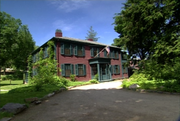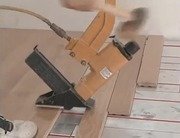Trim carpentry is always the most exciting part of any job 'cause you really see the finished renovation coming together.
In this room, our dining room, we had one piece of cabinet work that we restored or rather, we had all the paint removed.
It's the mantle piece, 'cause it has lot of elaborate detailing that we didn't want to lose.
However, all the other moldings in the room were so painted up that you had lost the ability to even see the detailing.
This window now has been cased out, and you can see how complicated all these little cuts are.
And Bob Riley over here, if I can interrupt you, you're working on the chair rails, right?
Right, we're just getting started on it.
And this again is a complicated replica of the original molding.
You can see all the different cuts there, and of course it's symmetrical.
What are you working on?
Well, we're going to coat this corner.
And that's what we've already done.
It's for the cross section of this trim, at a 45.
Well, why don't you just miterJoint in a corner like that.
Well, if we had two forty fives in here, they would want to spread apart when you nailed it, and also there's going to be some shrinkage going on here.
There's going to be lot less on a cope.
A cope is a much better joint.
OK.
And there's a lot going on in this trim, but I think we can still.
And it's a complicated cut.
Of course you using a coping saw.
Right, I'm going to highlight it all in pencil here so I can see it a lot easier.
Cut away the excess and then get back in to the fine line.
I guess there's just There's no power saw way of doing this, right Riley?
No.
Not with something like this and then for this.
Too much detail going on.
Nice, there it is.
See how it fits.
I'll be surprised if this fits the first try.
Yeah it looks like you have to do a little bit of fine-cutting, right?
That's pretty close.
Yeah.
If it was a lot, I'd use a scribes and scribe the whole thing over again, but all we have were a few high spots so I'm just going to mark those, and take that down with some 80 grit sandpaper.
Looks pretty good.
Yeah, that's good.
So now we still have to cut the length, 'cause it, we still left it long.
Of course.
That's the important thing to keep in mind.
That if you tried to cut it to fit from the beginning you might end up having a piece that's too short.
Right.
That's beautiful.
Ok, I am just cut to cut that still just a little bit long so we can force that in there.
There.
Beautiful fit, Bob.
Good.
Okay.
We'll tack it in place and then let's go look at the corner cupboard.
Okay.
Now the corner cupboard is one of the original features of the house that is pretty nicely Detailed, and one thing we discovered was that there were no doors here when we got the house, but originally there had been a pair of doors.
So Greg Rockman, the architect designed this particular door taking this square motif from the existing doors from the bottom of the cupboard; which have a very similar, very nicely crafted square as well as here in the casework , the same thing repeats.
And Danny Rafini has been working on recreating these.
Hi, Danny.
Hi.
You're just finishing up the glazing.
Yep.
Now, are you actually putting the glass into the windows with a hot melt glue gun?
Yeah.
So that works huh?
Yeah, just to mechanically fasten it.
Yeah.
And then over each one of these sides you've milled a little piece of...
Quarter inch.Quarter
inch stock.
How did you actually make the window, though?
Or the door, rather.
I cut it on a shaper.
A rail and stile cutter and you can see the profile right here around.
And that's how they're joined.
Yeah.
Just a rail and then the stile and I used a cope joint on the shaper.
Okay.
So are we done with this?
Yeah.
That's the beauty of the hot melt glue gun.
Okay.
So now this one's ready to be installed.
Riley?
Yeah.
Want to cut a couple of hinges in?
Sure.
All right.
These are all set to go.
Great.
Now the trick here is to start in the middle, right?
Yes.
We've already scored where the hinge is going so.
You scored it with a utility knife.
With a utility knife.
Danny's already done that.
Thanks.
That's a nice fit.
Good.
Yeah.
Yeah.
Okay.
So now we put the screws in.
And then we'll take it up to the door.
Okay.
Okay.
Oh, it's going to be handsome.
All right.
I'm gonna get the bottom first.
Now, all these little screws that come with the brass hinges are slot-headed screws.
So that we're really driving the screws by hand.
No Phillips heads here, right?
that's right, that's...
Well, Todd Allen has done a fabulous job of crafting this run of stairs up to the kitchen level, he's got one more run to do, but we're out of time.
Come home again next week.
We're going to be doing some more finished carpentry.
In fact we have plans for creating a paneled entryway between the main hall and the living room.
And also a very elaborate wooden cornice around the whole ceiling line of the living room.
And a trip to Newport, Rhode Island to visit the Isaac Bell house, one of the finest shingle style houses anywhere.
Til then, I am Bob Vila.
It is good to have you home again.







